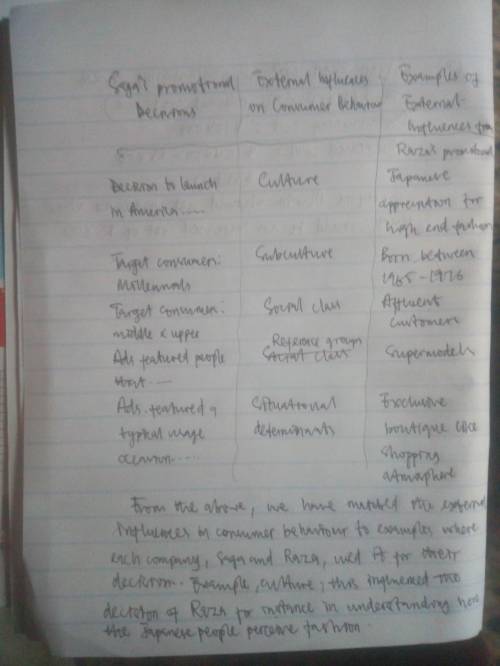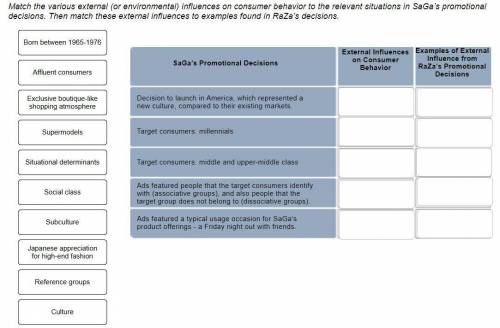
Business, 16.10.2020 05:01 vlactawhalm29
External Influences on Consumer Behavior SaGa is a European fashion store chain that specializes in accessible, trendy clothes and accessories for men and women. Its target audience includes fashion-conscious young men and women, ages 16-30. After success in Europe, SaGa is getting ready to launch its flagship stores in five U. S. markets-New York, Los Angeles, Chicago, San Francisco, and Miami. Based on its product offerings, SaGa is targeting millennials (those born between 1982 and 2000, also called gen Y). As a group, millennials are open to making impulse purchases, and are socially connected as demonstrated by their use of Twitter to tweet about products and brands. Also, based on its "accessible" price for its fashion offerings, Saga is targeting middle-to upper-middle-class millennials. SaGa's advertising agency of record was excited about the impending launch campaign in the U. S. and its first-ever foray into the American market, which is heavily influenced by celebrity and pop culture. The agency was developing a campaign that focused on "usage occasion"—the ad would show a group of friends, in their 20s, getting together for a Friday night out in the city. A social occasion such as a night out with friends, combined with the setting of a city street lined with trendy clubs and restaurants, highlighted a perfect usage occasion for wearing fashionable clothes from SaGa. In the ad, the friends walk through a busy city street that has a party atmosphere, and pass several other people whose fashion sense is not as trendy as theirs. As they pass these people, the contrast between their group and the other people is highlighted by the use of muted, fading colors (for the other people) versus bright and pleasing colors (for the group of friends wearing SaGa). The agency was thus contrasting those who do not wear SaGa, a dissociative group, with those who do. Meanwhile, Raza, a high-end fashion store chain in Europe, is planning to enter the Japanese market. RaZa's promotional strategy decisions include highlighting the purchase situation in their ads by showing the exclusive boutique store atmosphere, and by using international supermodels that denoted an aspirational group for their target audience. RaZa targeted older and more affluent consumers compared to SaGa; their target market consisted of upper-class gen X'ers in Japan (those born between 1946 and 1976). RaZa's research revealed that the Japanese culture understood and respected high-end fashion. The consumer does not make purchase decisions in isolation. A number of external factors have been identified that may influence consumer decision-making, such as culture, subcultures, social class, reference groups, and situational determinants. Match the various external (or environmental) influences on consumer behavior to the relevant situations in SaGa's promotional decisions. Then match these external influences to examples found in RaZa's decisions. Born between 1965-1976 SaGa's Promotional Decisions External Influences Examples of External on Consumer Influence from Behavior RaZa's Promotional Decisions Affluent consumers Exclusive boutique-like shopping atmosphere Decision to launch in America, which represented a new culture, compared to their existing markets. Supermodels Target consumers: millennials Situational determinants Target consumers: middle and upper-middle class Social class Ads featured people that the target consumers identify with (associative groups), and also people that the target group does not belong to (dissociative groups). Subculture Ads featured a typical usage occasion for SaGa's product offerings - a Friday night out with friends. Japanese appreciation for high-end fashion Reference groups Culture

Answers: 3


Other questions on the subject: Business

Business, 21.06.2019 21:00, live4dramaoy0yf9
In addition to having a bachelor's degree in accounting, a certification will increase a tax accountant's job opportunities and allow them to file reports with the
Answers: 1

Business, 22.06.2019 12:50, 20170020
Kyle and alyssa paid $1,000 and $4,000 in qualifying expenses for their two daughters jane and jill, respectively, to attend the university of california. jane is a sophomore and jill is a freshman. kyle and alyssa's agi is $135,000 and they file a joint return. what is their allowable american opportunity tax credit after the credit phase-out based on agi is taken into account?
Answers: 1


Business, 22.06.2019 21:00, nasrah
Dozier company produced and sold 1,000 units during its first month of operations. it reported the following costs and expenses for the month: direct materials $ 69,000 direct labor $ 35,000 variable manufacturing overhead $ 15,000 fixed manufacturing overhead 28,000 total manufacturing overhead $ 43,000 variable selling expense $ 12,000 fixed selling expense 18,000 total selling expense $ 30,000 variable administrative expense $ 4,000 fixed administrative expense 25,000 total administrative expense $ 29,000 required: 1. with respect to cost classifications for preparing financial statements: a. what is the total product cost
Answers: 2
You know the right answer?
External Influences on Consumer Behavior SaGa is a European fashion store chain that specializes in...
Questions in other subjects:

History, 12.06.2020 01:57

Social Studies, 12.06.2020 01:57






Chemistry, 12.06.2020 01:57

Mathematics, 12.06.2020 01:57





